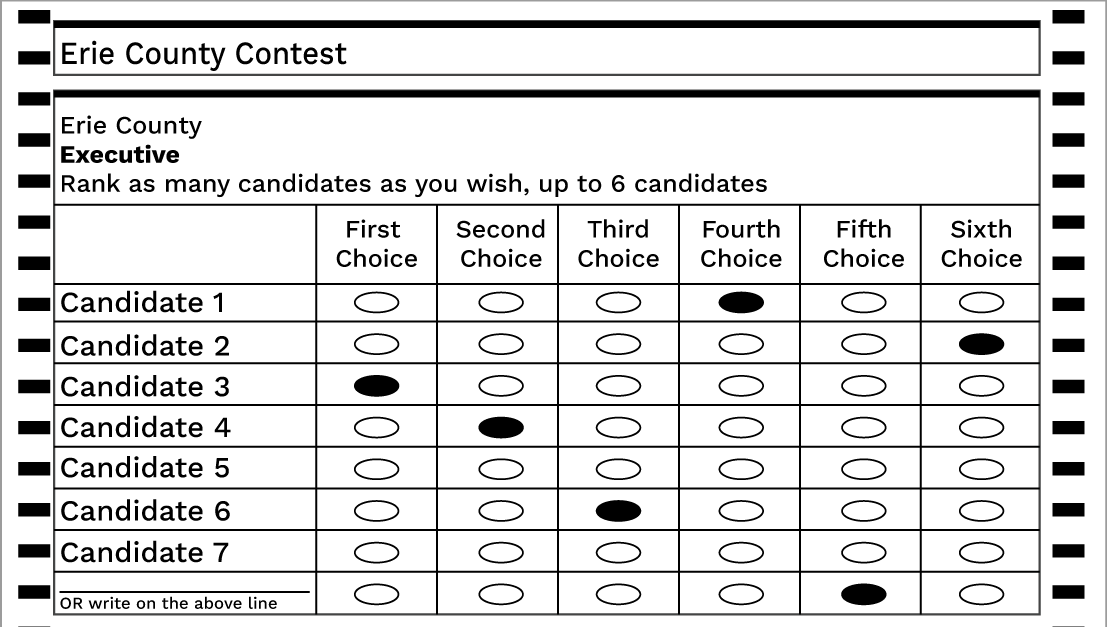RANKED CHOICE VOTING
Municipalities in Western New York utilize a plurality voting method for elections. This means that whichever candidate receives the most votes wins, whether or not they receive 50% of all votes. This reinforces the two-party system, division, and the status-quo.
Ranked Choice Voting (RCV) is a voting method that makes elections more fair. It can be used in elections with a single winner, like mayor or governor, and in elections with multiple winners, like city council or school board.
When municipalities utilize RCV, voters rank candidates in order of preference - first choice, second choice, third, and so on. If a candidate gets more than half of the first-choice votes, they win. If none of the candidates receives more than 50% of the votes, the candidate with the fewest votes is eliminated. Voters who chose the eliminated candidate as their first choice have their vote transferred to their second choice, and votes are tallied again. This instant runoff continues until one candidate has a true majority. RCV gives voters more voice - and ensures election winners have real, majority support.
Frequently asked questions
Why are we advocating for RCV?
Plurality voting often leaves women, communities of color, young people, renters, and other minority groups underrepresented. With RCV, diverse populations are more likely to use multiple rankings, boosting their voting power in the final tally.
In recent years, RCV helped elect the first Alaskan Native member of Congress, a majority-female NYC Council, and majority BIPOC councils in Minneapolis and Salt Lake City.
Where is RCV already working?
Maine and Alaska use RCV in statewide elections, New York City uses RCV for municipal primaries, and more than 62 U.S. jurisdictions have successfully implemented RCV. This nonpartisan voting method is utilized across the country, with municipalities across the political spectrum adopting this reform.
Is Ranked Choice Voting easy for voters to use?
We rank things in our lives on a daily basis. From our favorite foods, to our favorite artists - ranking is a common practice. With clear education and outreach, voters quickly adapt to RCV. In New York City’s 2021 election - the largest RCV rollout in the U.S. - 95% of voters found the ballot easy to understand. When communities are well-informed, RCV is just as accessible as plurality voting.
Does RCV reflect the will of the voters?
RCV ensures that winning candidates have majority support, not just a narrow plurality. RCV empowers voters to vote honestly and in a way that aligns with their values, rather than strategically. This means elections better reflect the overall preferences of the community - producing winners with stronger mandates to govern.
What do RCV ballots look like?
RCV ballots typically display candidates in rows and rankings in columns, allowing voters to easily mark their first, second, third choices, and so on. This simple grid layout is widely used. Some locations may use column-style or handwritten formats depending on their voting systems.
SAMPLE BALLOT
Does RCV eliminate the “spoiler effect”?
Yes. RCV allows voters to rank third-party or independent candidates without fear of wasting their vote on the “lesser of two evils” or helping elect their least-preferred candidate. This encourages a broader range of voices in our elections.
Does RCV encourage more candidates to run?
RCV encourages more candidates to run by reducing vote-splitting, leveling the playing field, and fostering coalition-building campaigns. Multiple studies have shown candidates in RCV elections are more likely to engage each other, and voters report lower levels of perceived negativity in campaigns.
Because candidates must not only appeal to their own base, but also to constituents’ second or third choice, RCV fosters more positive, issue-driven campaigns, opening the door for more diverse candidates, including women and candidates of color, to run and win.
What are the main arguments against RCV?
Critics claim that RCV is more complex than plurality voting, may confuse voters, and will be costly to implement. However, voter feedback has consistanly shown that with good outreach, RCV improves both representation and voter confidence.

